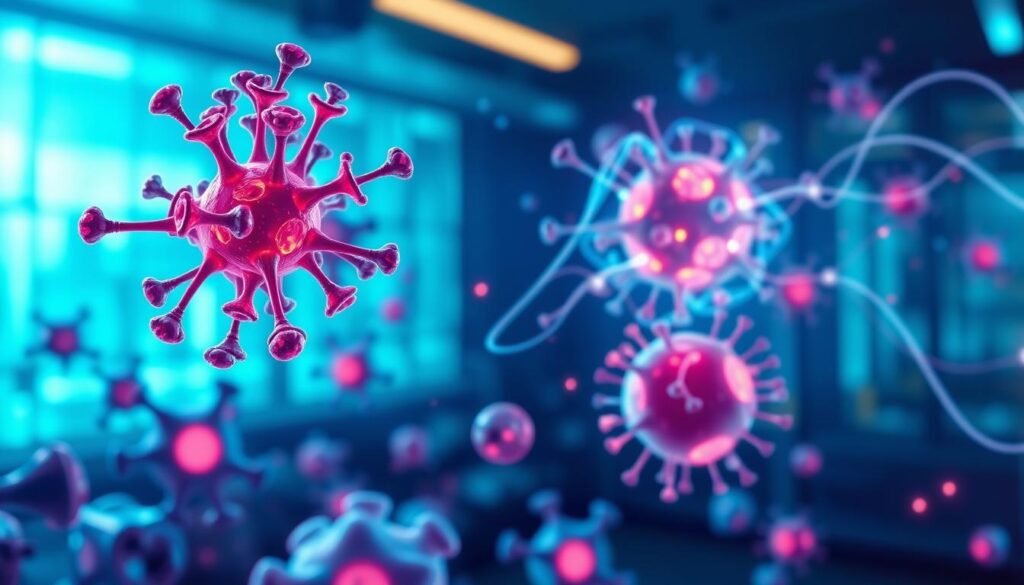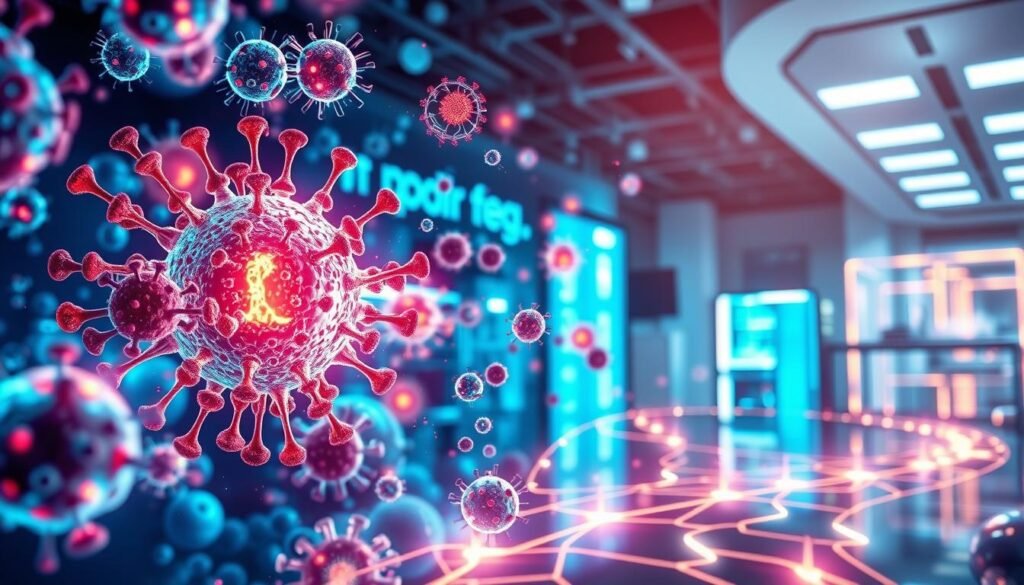Did you know that up to 85% of lung cancer cases are diagnosed at an advanced stage? This makes finding effective treatment quickly very important. As the top cause of cancer-related deaths around the world, it’s key to know the treatment options for advanced lung cancer. This article talks about the different treatments available and stresses the need for personalized treatment plans.
Advanced lung cancer, mostly non-small cell lung cancer (NSCLC), shows how far the disease has spread. As the cancer grows, treatment choices become more complex. This makes it important for patients and their doctors to know about the latest medical options. These options include targeted therapy, immunotherapy, chemotherapy, and radiation therapy. For example, targeted therapies that focus on genetic mutations like EGFR and ALK are offering new hope to patients.
Ongoing research is making treatment methods better and focuses on treatments just for you, based on your genes. For more information on how research is helping find better treatments for advanced lung cancer, visit NCI-supported research programs.
By knowing about these advances, people with advanced lung cancer can look for the best treatment. This can help them on their path to getting better.
Key Takeaways
- Advanced lung cancer refers to non-small cell lung cancer that has spread beyond the original tumor site.
- Timely treatment options can significantly influence patient outcomes and quality of life.
- Personalized treatment plans based on genetic testing are becoming standard in advanced lung cancer therapies.
- Combining therapies can improve treatment efficacy and survival rates for advanced lung cancer patients.
- Recent advancements in immunotherapy and targeted therapies are changing the treatment landscape for lung cancer.
- For the latest information on treatment options, consider exploring new drug approvals and research.
Understanding Advanced Lung Cancer
Advanced lung cancer is a major issue in cancer care. It’s mostly seen as non-small cell lung cancer (NSCLC) that has moved to stage III or IV. At these stages, cancer can spread beyond the lungs to other parts of the body. Things like smoking and being around certain toxins can raise the risk of getting it. Knowing about the stages is key to treating it and helping patients.
What is Advanced Lung Cancer?
Advanced lung cancer means the cancer has spread from the lungs to other areas. This mainly happens in NSCLC types, which make up about 85% of lung cancer cases. The common types are lung adenocarcinoma, squamous cell carcinoma, and large cell carcinoma. Each kind has its own treatment methods. Finding out you have advanced lung cancer can be very scary. This makes getting the right information and support very important.
Stages of Lung Cancer and Their Implications
The stage of lung cancer helps doctors figure out the best treatment. About 17.6% of people have stage III, and 40% have stage IV, where the cancer has spread far, like to the bones or brain. The goal of treating late-stage lung cancer is to make symptoms better and improve life quality since curing it might not be possible. Knowing about NSCLC is important for patients, although survival rates are low.
Recent treatments have helped some people live longer. Surgery and radiation are more for the early stages. But they can also be combined with other treatments in more advanced stages.
Current Treatment Options for Advanced Lung Cancer
The way we treat advanced lung cancer keeps getting better. Patients now have many options to choose from. Deciding on a treatment involves looking at the cancer’s traits and the patient’s health. Options include surgery, chemotherapy, radiation therapy, targeted therapies, and immunotherapy. Each method has the goal of fighting the cancer while managing side effects.
Overview of Treatment Modalities
There are many ways to treat advanced lung cancer. Some may require surgery, like a wedge resection or lobectomy. This is more common in the early stages. For advanced cancer, chemotherapy might be used in several cycles to help symptoms and prolong life. Radiation therapy is important too, used before or after surgery.
New treatments like targeted therapy and immunotherapy attack the cancer cells or boost the immune system. Places like UChicago Medicine offer the latest in lung cancer care. They aim to give patients treatments that are right for them.
Combination Therapies
Using different treatments together has greatly improved care for advanced lung cancer. This can make each treatment work better. For example, chemotherapy and radiation together can better shrink tumors and reduce the risk of cancer coming back. In cases where cancer has spread, combining targeted therapies and immunotherapy can be very effective.
This approach has made people with lung cancer live longer than before. It shows how treatment and research have advanced. You can find more information on these treatments here.

Treatment for Advanced Lung Cancer: Targeted Therapy
Targeted therapy is a modern way to fight advanced lung cancer. It doesn’t harm healthy cells like traditional treatments do. Instead, it uses drugs that focus solely on cancer cells. This method lowers damage to good cells, making it better for many patients.
What is Targeted Therapy?
Targeted therapy uses drugs that zero in on cancer’s specific genetic changes. For example, a small percentage of lung cancers show an ALK gene change. Others may have a certain KRAS mutation. Because of this selectivity, targeted therapy works well and has fewer side effects. It’s key for patients with these genetic markers.
Recent Advances in Targeted Therapies
Lately, there have been big steps forward in targeted therapy for lung cancer. Drugs like ALK inhibitors are used for patients with an ALK mutation. EGFR inhibitors are chosen for those with certain EGFR mutations. With the discovery of ROS1 rearrangements, treatment choices have become more complex. Tests that find these markers are critical in picking the right therapy.

Targeted therapies come in easy-to-take forms, like pills or IVs. This makes treatment simpler for patients. However, not all lung cancer patients can use these therapies. Their success varies, highlighting the need for treatments that match each person’s cancer profile.
Immunotherapy: A New Era in Lung Cancer Treatment
Immunotherapy is transforming the battle against lung cancer. It boosts the body’s immune system to fight cancer cells. This innovative treatment offers new hope to those with advanced lung cancer.
Mechanism of Immunotherapy
Immunotherapy works by making the body’s immune system stronger. It uses agents to block proteins that hold back immune responses. As a result, immune cells can better attack and beat cancer cells. Clinical trials show these methods increase survival rates.
Current Immunotherapy Agents
Today, several immunotherapy drugs are making a big difference in lung cancer care. Key drugs include:
- Pembrolizumab: Works well for people with high levels of a specific marker. The KEYNOTE-189 study showed a 69.2% survival rate at 12 months when used with chemo.
- Nivolumab: Has a median survival of 12.2 months in certain lung cancers, better than old treatments.
- Atezolizumab: Also increases survival rates, especially in patients who have had treatment before.
Using these drugs with chemo greatly improves survival. For example, the CheckMate-227 study found significant benefits using nivolumab with another drug compared to standard treatments.
For more information on top lung cancer doctors, check out the best lung cancer specialists.

Chemotherapy: Traditional Treatment Approach
Chemotherapy is crucial for treating advanced lung cancer, especially for those who can’t access new treatments. It uses strong drugs to kill fast-growing cancer cells. Knowing the strengths and weaknesses of chemotherapy is vital for patients and doctors.
Current Chemotherapy Drugs in Use
Some chemotherapy drugs are key in treating advanced lung cancer. The most used include:
- Cisplatin
- Carboplatin
Cisplatin works better than carboplatin in some cases. It often comes with other drugs to boost survival rates by 11% compared to carboplatin alone. Patients usually have four to six cycles of treatment, based on how they respond.
Effectiveness and Limitations of Chemotherapy
Chemotherapy improves survival for advanced lung cancer patients. For instance, with platinum-based drugs, the survival rate jumps to 15% from 5% in a year. But, side effects like nausea, hair loss, and nerve pain can reduce life quality.
Still, challenges remain despite progress in treatments. Lifespan was just two to four months before chemotherapy became common, showing how tough lung cancer is to fight. For non-small cell lung cancer (NSCLC), the situation is complicated. Factors like EGFR mutations or PD-L1 expression affect treatment. Only some patients can get targeted therapies, so chemotherapy remains essential.
Radiation Therapy: When and Why It’s Used
Radiation therapy is key in treating advanced lung cancer. It’s used when removing the cancer through surgery isn’t possible. This includes easing symptoms, shrinking tumors, or killing off remaining cancer cells post-surgery. Knowing about the different radiation therapies helps patients and healthcare professionals choose the right option.
Types of Radiation Therapy
Different radiation therapies are aimed at lung cancer treatment. Each is designed to target the cancer effectively:
- External Beam Radiation Therapy (EBRT): This common type sends high-energy rays to the cancer from outside the body.
- Stereotactic Body Radiation Therapy (SBRT): For early-stage cancers or ones that haven’t spread much, SBRT uses few sessions of high-dose radiation with minimal harm to healthy tissues.
- Intensity Modulated Radiation Therapy (IMRT): An advanced method that adjusts radiation beam intensity. It targets the tumor closely while safeguarding nearby organs.
- Proton Therapy: Protons, instead of X-rays, lessen the chance of damaging healthy tissue. It’s especially good for certain cases.
- Brachytherapy: This places radioactive seeds close to or inside the tumor. It aims to shrink the tumor with little damage to the surroundings.
- Volumetric Modulated Arc Therapy (VMAT): Similar to IMRT, VMAT rotates around the patient. It increases accuracy of treatment and decreases healthy tissue exposure.
- Four-Dimensional Conformal Radiation Therapy (4DCT): This captures the tumor’s movement during breathing. It allows for precise treatment at every breath phase.
Patients typically undergo radiation treatments five days a week. These treatments may be part of a broader plan that includes chemotherapy. Side effects like skin irritation, fatigue, and nausea are common but tend to go away after a few months. Follow-up appointments after treatment are important to check recovery and handle long-term side effects.
Palliative Care: Enhancing Quality of Life
Palliative care is key for lung cancer treatment. It focuses on making life better by easing symptoms and managing pain. It helps patients feel better, no matter their disease stage. This care is vital for those with advanced lung cancer.
Goals of Palliative Care in Lung Cancer
The goals of palliative care in lung cancer treatment focus on comfort and emotional well-being. Key objectives include:
- Alleviating physical discomfort and pain.
- Providing psychological support for patients and families.
- Enhancing communication between patients and healthcare providers.
- Facilitating advance care planning for future healthcare needs.
Early palliative care makes a big difference in quality of life. A study with over 23,000 Veterans showed those who started care early lived longer. You can learn more about supportive palliative care here.
Strategies for Effective Palliative Care
Effective strategies for palliative care improve patient care. Recommended approaches include:
- Using stepped palliative care models to match care with patient needs.
- Encouraging early treatment preference and care goal discussions.
- Offering outpatient palliative care services to manage symptoms early.
- Regularly assessing quality of life and adjusting care plans as needed.
Patients receiving stepped palliative care make fewer visits without losing quality of life. These strategies improve access to important services. They help patients control their treatment journey.
Palliative care provides a supportive network. It reduces anxiety and depression, leading to higher satisfaction for patients and families. Patients are encouraged to discuss palliative care as part of their treatment. Often, insurance covers these services.
The Role of Clinical Trials in Advanced Lung Cancer Treatment
Clinical trials are key in advancing lung cancer treatments. They give patients access to new options not found in regular treatments. These trials test new drugs and methods to fight and find lung cancer early. They let people try the latest therapies and help advance research.
Patients in these studies may get the best current treatments, new meds, or sometimes a placebo. This is all part of the research.
Benefits of Participating in Clinical Trials
Joining clinical trials has many benefits. Participants get special care and monitoring from the study’s team. This makes sure their health is always put first. This care might lead to better health outcomes.
Also, clinical trials let patients at any lung cancer stage try new treatments. This can give hope and power to both patients and their families.
Current Ongoing Trials for Advanced Lung Cancer
Right now, the U.S. has many trials for advanced lung cancer. These focus on immunotherapy, targeted treatments, and drug combos. With lung cancer affecting so many, the search for new treatments is vital.
Patients should talk about the risks and benefits of these trials with their doctors. While insurance may cover some costs, there might be extra expenses. Still, taking part in these trials can lead to new, effective treatments. It also helps the whole field of lung cancer research move forward.